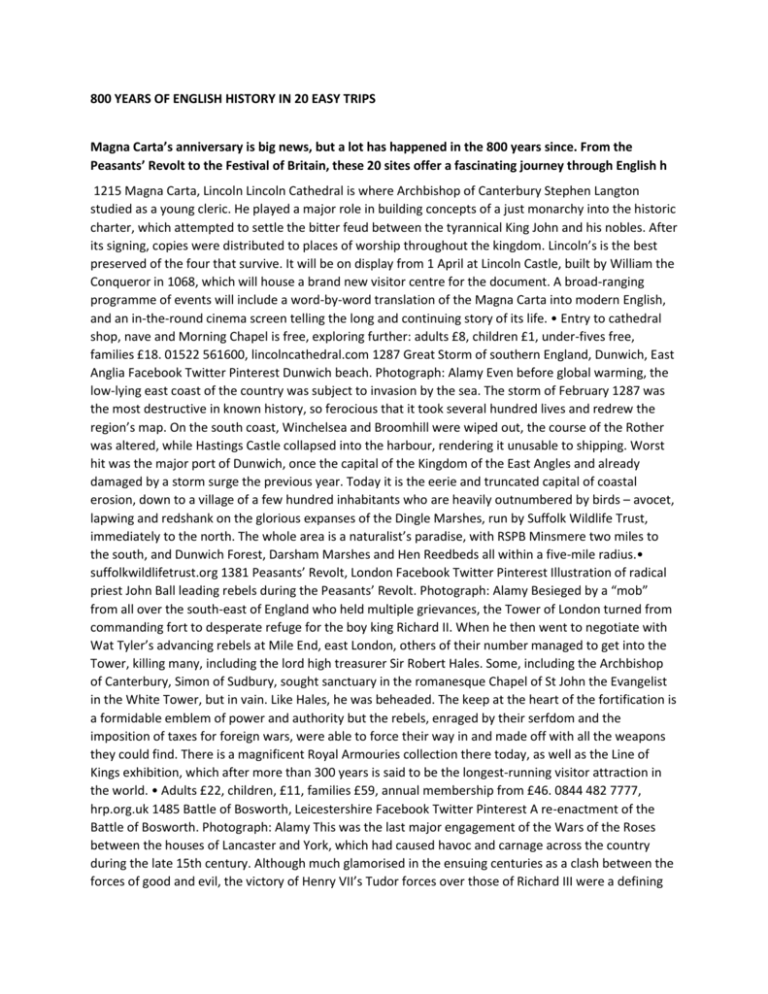TNU - 800 YEARS OF ENGLISH HISTORY IN 20 EASY TRIPS
advertisement

800 YEARS OF ENGLISH HISTORY IN 20 EASY TRIPS Magna Carta’s anniversary is big news, but a lot has happened in the 800 years since. From the Peasants’ Revolt to the Festival of Britain, these 20 sites offer a fascinating journey through English h 1215 Magna Carta, Lincoln Lincoln Cathedral is where Archbishop of Canterbury Stephen Langton studied as a young cleric. He played a major role in building concepts of a just monarchy into the historic charter, which attempted to settle the bitter feud between the tyrannical King John and his nobles. After its signing, copies were distributed to places of worship throughout the kingdom. Lincoln’s is the best preserved of the four that survive. It will be on display from 1 April at Lincoln Castle, built by William the Conqueror in 1068, which will house a brand new visitor centre for the document. A broad-ranging programme of events will include a word-by-word translation of the Magna Carta into modern English, and an in-the-round cinema screen telling the long and continuing story of its life. • Entry to cathedral shop, nave and Morning Chapel is free, exploring further: adults £8, children £1, under-fives free, families £18. 01522 561600, lincolncathedral.com 1287 Great Storm of southern England, Dunwich, East Anglia Facebook Twitter Pinterest Dunwich beach. Photograph: Alamy Even before global warming, the low-lying east coast of the country was subject to invasion by the sea. The storm of February 1287 was the most destructive in known history, so ferocious that it took several hundred lives and redrew the region’s map. On the south coast, Winchelsea and Broomhill were wiped out, the course of the Rother was altered, while Hastings Castle collapsed into the harbour, rendering it unusable to shipping. Worst hit was the major port of Dunwich, once the capital of the Kingdom of the East Angles and already damaged by a storm surge the previous year. Today it is the eerie and truncated capital of coastal erosion, down to a village of a few hundred inhabitants who are heavily outnumbered by birds – avocet, lapwing and redshank on the glorious expanses of the Dingle Marshes, run by Suffolk Wildlife Trust, immediately to the north. The whole area is a naturalist’s paradise, with RSPB Minsmere two miles to the south, and Dunwich Forest, Darsham Marshes and Hen Reedbeds all within a five-mile radius.• suffolkwildlifetrust.org 1381 Peasants’ Revolt, London Facebook Twitter Pinterest Illustration of radical priest John Ball leading rebels during the Peasants’ Revolt. Photograph: Alamy Besieged by a “mob” from all over the south-east of England who held multiple grievances, the Tower of London turned from commanding fort to desperate refuge for the boy king Richard II. When he then went to negotiate with Wat Tyler’s advancing rebels at Mile End, east London, others of their number managed to get into the Tower, killing many, including the lord high treasurer Sir Robert Hales. Some, including the Archbishop of Canterbury, Simon of Sudbury, sought sanctuary in the romanesque Chapel of St John the Evangelist in the White Tower, but in vain. Like Hales, he was beheaded. The keep at the heart of the fortification is a formidable emblem of power and authority but the rebels, enraged by their serfdom and the imposition of taxes for foreign wars, were able to force their way in and made off with all the weapons they could find. There is a magnificent Royal Armouries collection there today, as well as the Line of Kings exhibition, which after more than 300 years is said to be the longest-running visitor attraction in the world. • Adults £22, children, £11, families £59, annual membership from £46. 0844 482 7777, hrp.org.uk 1485 Battle of Bosworth, Leicestershire Facebook Twitter Pinterest A re-enactment of the Battle of Bosworth. Photograph: Alamy This was the last major engagement of the Wars of the Roses between the houses of Lancaster and York, which had caused havoc and carnage across the country during the late 15th century. Although much glamorised in the ensuing centuries as a clash between the forces of good and evil, the victory of Henry VII’s Tudor forces over those of Richard III were a defining moment in English and Anglo-Welsh history; this was the start of the Tudor dynasty and a death blow to the Plantagenets. The drama of Bosworth has continued into the 21st century with the discovery of Richard’s remains beneath a Leicester car park. There is an imaginative reconstruction of the battle at the Bosworth Battlefield heritage centre in the village of Sutton Cheney, with interactive displays, reenactment groups, falconry, archery, armour and studies of Tudor warfare.• Adults £7.95, children £4.75, families from £17.50. 01455 290429, bosworthbattlefield.com 1539 Dissolution of the monasteries, Glastonbury, Somerset Facebook Twitter Pinterest Glastonbury Abbey ruins. Photograph: Alamy Revolution from the top, as King Henry VIII got rid of 900 monasteries in five years, in the process dispersing 15,000 monks and nuns. The money from selling their land was intended to increase the revenue of the crown, but in fact went towards funding Henry’s foreign wars. The tower on top of Glastonbury Tor, made famous again by its exposure during the music festival, is not a remnant of the Abbey, but of St Michael’s Church. The lordly ruins of the larger building, once the second wealthiest abbey after Westminster, lie on the land below. King Arthur is said to be buried with his knights in the tor, awaiting a summons to come and save the realm. The town is steeped in Avalonian and other legends, and a good starting point for excursions into the Somerset Levels, now sadly famous for flooding. The excellent Abbey Museum has got the history of it all.• Adults £6.90, children £4.30, families £17.80. 01458 832267, glastonburyabbey.com 1611 King James Bible, Chapel Royal, Hampton Court, London Facebook Twitter Pinterest Chapel Royal, Hampton Court Palace. Photograph: Alamy It was in this magnificent chapel that the newly crowned King James I worshipped while overseeing the work which was to produce the 1611 version of the Holy Bible. In 1604, he convened the Hampton Court Conference in order to set in train a translation, accomplished by 47 scholars, which would properly reflect the vision and structure of the Church of England. The influence of that Church’s founder, Henry VIII, hangs over everything in the form of the breathtakingly ornate ceiling built at his instruction. Still a fully functioning chapel with an excellent resident choir, its features include baroque reredos and wall paintings as well as the box pews and tiled flooring which date from the early 18th century. • You can attend chapel services without paying the palace entry fee. Regular Sunday services: 11am Choral Matins or Sung Eucharist, 1pm lunchtime music recitals, 2.15pm rehearsals of the choir, 3.30pm Evensong. 020-3166 6515, chapelroyal@hrp.org.uk 1620 Sailing of the Mayflower, Plymouth, Devon Facebook Twitter Pinterest The signing of the Mayflower Compact. Photograph: North Wind Picture Archives/Alamy The boat was an ageing square-rigged merchant vessel, about 100 feet long and 25 wide. Aboard were 102 men and women, including crew, entrepreneurs and religious dissenters. This last group were the so-called Pilgrim Fathers, who sailed from Plymouth on 6 September, 1620, giving the town’s name to New England’s first permanent European settlement, which they founded in December that year. The Plymouth colony’s first governing document, the Mayflower Compact, represents the exporting of democracy from the old world to the new. The story is graphically told in Plymouth’s (Devon) Mayflower Museum on the bustling Barbican. The Mayflower Steps stand close to the site where the ship set sail, but this is not the actual flight which the Pilgrims descended. Those vanished long ago beneath the Victorian pub, the Admiral MacBride. • Adults £2, children £1.50, families £5, 01752 306330, plymouth.gov.uk 1649 English Civil War, Pontefract Castle, West Yorkshire Facebook Twitter Pinterest Pontefract Castle – the last stronghold of the royalists in the English Civil War. Photograph: Rolf Richardson/Alamy Once the most powerful castle in the kingdom, the place where Shakespeare’s doomed Richard II laments his condition, and the very last stronghold to fall to Oliver Cromwell’s parliamentarian forces. Even after Charles I had been beheaded in January 1649, the royalists hung on here, declaring the king’s son to be the rightful heir as Charles II. When the castle finally fell, Cromwell persuaded the villagers to help “slight” (destroy) the troublesome redoubt. This they never fully achieved, and when Victoria reigned, centuries later, it became used for growing and storing liquorice. Hence the castle’s picture on Pontefract Cake labels. Now English Heritage and the National Lottery Fund have ridden to its rescue, opening parts of the castle that have been cut off since the Civil War. There are chilling ghost-walks and tours of the ammunition stores, with excellent historical context in the Education Room.• Free admission, tours: adults £2.20, children £1.10. 01977 723 440, wakefield.gov.uk/castles 1745 Jacobite Rebellion, Cumbria Facebook Twitter Pinterest Carlisle Castle – captured briefly by Bonnie Prince Charlie in 1745. Photograph: Nigel Hillier Drive westwards along the B6318, from Greenhead towards Carlisle, and you are travelling along a line of history. Beneath the tarmac on this scenic alternative to the A69 west of Haltwhistle are the stones of the old military road constructed to repel 18th century Jacobite invaders from Scotland. You can see where the material came from by the gaps in Hadrian’s Wall. In 1745, while most of the British Army was in Europe engaged in the War of the Austrian Succession, Bonnie Prince Charlie led the rebels in an effort to re-establish a Stuart monarchy. On their way south – they got as far as Derby – they briefly held the city of Carlisle. Go through Brampton and you can see the spot where several of the rebels were later hanged. In the city of Carlisle, there’s no avoiding the formidable and well preserved castle, with its famous Museum of Military Life, in which a millennium of uneasy border life can be viewed. Here are the famous licking stones, so-called because thirsty prisoners tried to extract moisture from them.• Adults £5.90, children £3.50, families £10. 01228 532774, cumbriasmuseumofmilitarylife.org 1760-1840 Industrial Revolution, Dudley, West Midlands Facebook Twitter Pinterest Black Country Museum guides in action. Photograph: Alamy The Black Country, to the west of Birmingham, stood on the thick, rich coal seams which were to power Britain to the forefront of manufacturing nations. Close to the pleasant hills of south Shropshire, this region of some 20 expanding small towns, each specialising in a particular metal trade, was the first sizeable industrial landscape in the world. By the middle of the 19th century, it was producing more than a fifth of the country’s iron, supplying the cast-iron pillars for the Great Exhibition at Crystal Palace in 1851, the US’s first steam locomotive, and the anchors for such mighty vessels as the Titanic and Brunel’s SS Great Britain. At the Black Country Living Museum in Dudley, witness the process which set in train the nation’s shift from rural to urban. Here you can walk through scenes of those times: the limekilns, the Newcomen engine house, the chain makers, the canal wharfs. You can even go down into the “10-yard seam” of the drift mine.• Adults £15.50, children £7.25, families £45. 0121-557 9643, bclm.com 1773 Enclosure Act, Helpston, Northamptonshire Facebook Twitter Pinterest John Clare’s cottage birthplace in Helpston. Photograph: Holmes Garden Photos/Alamy This was the first major parliamentary act to authorise the enclosing of tracts of hitherto common land. The practice increased dramatically throughout the country in the late 18th and early 19th centuries as the population rose and the existing open field system struggled to produce sufficient food. One of the areas most affected was central southern England, where it caused widespread destitution of the landless poor and great depopulation of the countryside. By the end of the 19th century some 5,000 individual acts had been implemented and about 11,000 square miles enclosed. Born in Northamptonshire 20 years after the 1773 act, the so-called peasant poet John Clare wrote the most passionate and highly regarded laments for the loss of open land. John Clare’s cottage, where he was born and lived for the first 40 years of his life, has been restored and furnished to resemble the condition of his time and hosts regular events celebrating his life and work.• Adults £4.50, children £3.85, families £15. 01733 253330, clarecottage.org 1805 Battle of Trafalgar, Chatham Dockyard, Kent Facebook Twitter Pinterest Orford Smith’s lithograph of The Hero of the Trafalgar by William Heysbam Overend. Photograph: Fine Art Photographic Library/CORBIS After this crucial victory, naval supremacy over the French was assured. Nonetheless, Britain had to take action to prevent ships of the lesser European navies being taken by the French, and to maintain blockades of enemy bases. The following decades saw a massive build-up of shipbuilding at this historic Medway dockyard. Here are the massive covered slips designed to shelter timber vessels and prevent them from rotting during their long periods of manufacture. Here, too, are perfectly preserved historic warships, workshops, Victorian ropery and the interactive Hearts of Oak gallery through which you can join in the work of a ship’s carpenter. • Adults £19, children £11.50, families £49.50. 01634 823800, thedockyard.co.uk 1807 Slave Trade Act, Liverpool Facebook Twitter Pinterest Albert Dock. Photograph: Chris Hepburn/Getty Images Although slavery was not abolished throughout the British Empire until 1833, this was the act that outlawed commercial trafficking. The International Slavery Museum offers a bold and clear-eyed history of the brutal practice from which personal and national fortunes were made. Just across Albert Dock from The Beatles Story, the museum gives a clear exposition of the trade triangle, running between European ports such as this one, the West African coast and the Americas, from which slave-produce such as sugar, rice and tobacco was brought. Harrowing but informative highlights include an interactive experience of the triangle’s Middle Passage, and scenes from a St Kitts sugar plantation in 1800. Chilling details too of the continuation of slavery in various parts of the world.• Admission free. 0151-478 4499, liverpoolmuseums.org.uk 1832 Reform Act, Newcastle-upon-Tyne Facebook Twitter Pinterest Grey’s Monument Photograph: Logan Rosen/flickr Charles, 2nd Earl Grey of Howick Hall, Northumberland, prime minister from 1830 to 1834, stands 130 feet above the roofs of Newcastle on his Grade I-listed column. Grey’s Monument was designed by Edward Hodges Bailey, who did something similar for Lord Nelson in London, and honours Grey for his backing of the reform which nearly doubled the electorate at a stroke and paved the tortuous way towards full enfranchisement. Today, the base of his statue is a rallying point for protesters, activists and would-be orators. It is also at the centre of some superb historic walks around the places of his time, including the classic planned centre of Grainger Town, and the Victoria coal tunnel down to the jetties of the Tyne. There is a fabulous view from the top of the monument, with its 164 dark, cramped steps.• Tower access: adults £4, children £2, (advisable to book in advance). 0191277 8000, newcastlegateshead.com 1932 Kinder Scout Mass Trespass, Peak District, Derbyshire Facebook Twitter Pinterest A view worth fighting for … Kinder Scout. Photograph: Eli PascallWillis/Alamy One of the most famous and successful acts of civil disobedience in English history was sparked by denial of access to the grouse moors of this Peak plateau, with groups of ramblers converging in defiance of gamekeepers’ threats. Five of the walkers were arrested – and some of these were jailed for up to six months on charges of violence. The episode helped bring about the 1949 National Parks and Access to the Countryside Act, which in turn fuelled the rambling boom of the postwar decades. Kinder Scout, now much climbed, is something of a monument to the trespass, commanding enormous views of the hills between Manchester and Sheffield. It is also a focal point of the Pennine Way, the first long-distance footpath established after the passage of the Act.• ramblers.org.uk, nationaltrust.org 1914-18 First world war, London Facebook Twitter Pinterest The Cenotaph on Remembrance Sunday. Photograph: Paul Brown/Alamy The war to end all wars. Or not. The first major conflict in which the ranks, as well as the generals, were publicly honoured by name in stone. In the years after the slaughter, crosses listing the fallen sprang up in bereaved towns and villages across the country. The Whitehall Cenotaph, (from the Greek, meaning empty tomb) is the work of the great country house architect Edwin Lutyens. It replaced, in 1920, the temporary structure that had been erected in response to public feeling. The solemn tiered slab of Portland stone is the capital of commemoration, still the focal point of national memory every November 11. 1939-45 Second world war, Tyneham, Dorset Facebook Twitter Pinterest Tyneham’s old school house, reincarnated as a museum. Photograph: Alamy Biggest war in world history, 30 nations, 50 million-plus killed, darkest days, finest hours … what else is there to say? It wasn’t just people giving their lives, but places too. None more vividly than the tiny, time-frozen village of Tyneham, once owned by William the Conqueror’s half-brother Robert. Four years into the war it was taken over by the War Office so the surrounding land could be used for firing ranges. Although there was an understanding that it would be given back to its residents after the war, it was the subject of a compulsory purchase by the Army in 1948 and has remained in use ever since. The village is now a compelling, if sad, Hardyesque relic, with storyboards in the ruined cottages telling of their families’ lives, and the old school house reincarnated as a museum. Tranquil and by-passed by postwar England – except when the guns are firing on the nearby ranges.• £2 donation per car, tynehamopc.org.uk 1951 Festival of Britain, South Bank and the Museum of London Facebook Twitter Pinterest The Dome of Discovery at the Festival of Britain. Photograph: Getty Images Conceived in the dark days of the war a decade earlier, this mighty exhibition, costing £10 million, was a bright postcard to tell the rest of the world that Britain was back in business. Partly a celebration of national legacy and partly a stylistic manifesto for recovery, it boasted the floating cigar shape of the Skylon, the Dome of Discovery with its echoes of the Great Exhibition a century before, and the stridently modern concert building, the Royal Festival Hall. The Conservatives, returning to power in 1951 after six years of Clement Attlee’s government, saw it as a hymn to Labour and tore much of it down. Eight million people visited the South Bank exhibition, leading to its development as a major international complex for the arts, including the still-thriving National Theatre, British Film Institute, Queen Elizabeth Hall, Hayward Gallery and Imax cinema. Thousands of images, leaflets, programmes and memorabilia from the Festival are on display at the Museum of London, near the Barbican.• Museum of London: admission free, museumoflondon.org.uk. South Bank: southbankcentre.co.uk, http://www.southbanklondon.com/ 1984-85 The Miners’ Strike, Durham Facebook Twitter Pinterest Blast Beach at Dawdon on Durham’s Heritage Coast. Photograph: LatitudeStock/Alamy The most bitter confrontation in the country’s industrial history, this year-long dispute over pit closures marked the beginning of the end for domestic coal mining and victory for prime minister Margaret Thatcher. It was a violent, divisive battle, with the police fiercely criticised for their heavy-handedness. The strike changed the political map irrevocably and greatly weakened the trade union movement. Thirty years on, the so-called black beaches of Durham, once darkened by the spoil from the collieries of Easington, Horden, Hawthorn and Blackhall, look nothing like they did in the final scenes of Get Carter (1971). Much of the coast is now a nature reserve, with a “Durham Heritage” footpath from Seaham to Crimdon passing close to the old mines.• durhamheritagecoast.org 2015 800th anniversary of Magna Carta, Runnymede, Surrey Facebook Twitter Pinterest Magna Carta memorial at Runnymede. Photograph: Alamy Months of celebrations are planned around 15 June, the date of the great charter’s sealing 800 years ago. There will be medieval fairs at the nearby towns of Egham and Wraysbury, fireworks, peals of bells, beacon-lighting and river relays. Also, there’ll be a visit by the American Bar Association – the US constitution was greatly influenced by the Charter’s principles. The meeting between King John and his barons is thought to have taken place on Magna Carta Island in the Thames at Runnymede. The area is awash with monuments, including the Magna Carta memorial itself, the lodge and pier by Edwin Lutyens and the commemorative stone for President Kennedy, dedicated jointly by the Queen and Jacqueline Kennedy in May 1965. Don’t miss the invincible Ankerwycke Yew nearby, claimed to be the country’s oldest tree, at 1,400 years or more.• For a full list of events, see magnacarta800th.com






